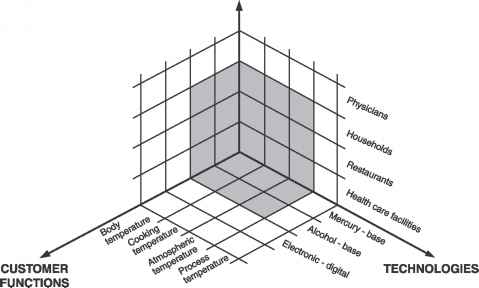Customer Groups

An adequate business definition requires proper consideration of the strategic three Cs: customer (e.g., buying behavior), competition (e.g., competitive definitions of the business), and company (e.g., cost behavior, such as efficiencies via economies of scale; resources/skills, such as financial strength, managerial talent, engineering/manufacturing capability, physical distribution system, etc.; and differences in marketing, manufacturing, and research and development requirements and so on, resulting from market segmentation).
Typology of Abell proposed defining business in terms of three measures: scope, differentia-Business tion across segments, and differentiation across competitors. According to Abell, Definitions scope and both kinds of differentiation are related to one another in complex ways. One way to conceptualize these interrelationships is in terms of a typology of business definitions. Three alternative strategies for defining a business are recommended: (a) a focused strategy, (b) a differentiated strategy, and (c) an undif-ferentiated strategy.
• Focused strategy—A business may choose to focus on a particular customer group, customer function, or technology segment. Focus implies a certain basis for segmentation along one or more of these dimensions, narrow scope involving only one or a few chosen segments, and differentiation from competitors through careful tailoring of the offering to the specific need of the segment(s) targeted.
• Differentiated strategy—When a business combines broad scope with differentiation across any or all of the three dimensions, it may be said to follow a differentiated strategy. Differentiation across segments may also be related to competitive differentiation. By tailoring the offering to the specific needs of each segment, a company automatically increases the chance for competitive superiority. Whether or not competitive differentiation also results is purely a function of the extent to which competitors have also tailored their offerings to the same specific segments. If they have, segment differentiation may be substantial, yet competitive differentiation may be small.
• Undifferentiated strategy—When a company combines broad scope across any or all of the three dimensions with an undifferentiated approach to customer group, customer function, or technology segments, it is said to follow an undifferenti-ated strategy.16
Each of these strategies can be applied to the three dimensions (customer groups, customer functions, and technologies) separately. In other words, 27 different combinations are possible: (a) focused, differentiated, or undifferentiated across customer groups; (b) focused, differentiated, or undifferentiated across customer functions; (c) focused, differentiated, or undifferentiated across technologies, and so on.
A focused strategy serves a specific customer group, customer function, or technology segment. It has a narrow scope. Docutel Corporation's strategy in the late 1960s exemplified a focused strategy relative to customer function. When Docutel first pioneered the development of the automated teller machine (ATM), it defined customer function very narrowly, concentrating on one function only— cash dispensing.
A differentiated strategy combines broad scope with differentiation across one or more of the three dimensions. A differentiated strategy serves several customer groups, functions, or technologies while tailoring the product offered to each segment's specific needs. An example of a differentiated strategy applied to customer groups is athletic footwear. Athletic footwear serves a broad range of customer groups and is differentiated across those groups. Tennis shoes are tailored to meet the needs of one specific customer group; basketball shoes, another.
An undifferentiated strategy combines a broad scope across one or more of the three dimensions. This strategy is applied to customer groups in a business that serves a wide range of customer groups but does not differentiate its offerings among those groups. Docutel's strategy was focused with respect to customer function but not with respect to customer groups: they offered exactly the same product to commercial banks, savings and loans, mutual savings banks, and credit unions. To sum up, the strategy that a business chooses to follow, based on the amount of scope and differentiation applied to the three dimensions, determines the definition of the business.
Continue reading here: Sbu Objectives And Goals
Was this article helpful?
Readers' Questions
-
venera1 year ago
- Reply
-
esther1 year ago
- Reply
-
Brody1 year ago
- Reply